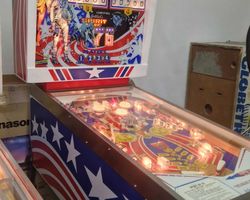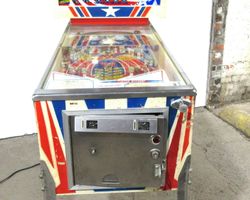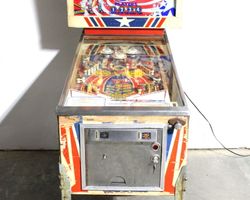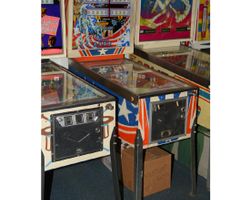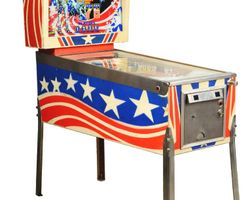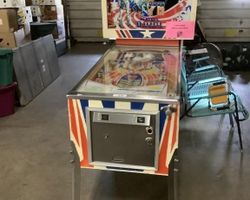Spirit of 76
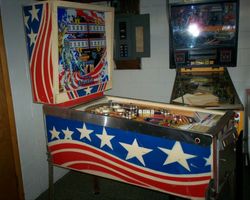
Average Prices: USD $300 to $1,000
Produced: December, 1975
Production Run: 10,569 units
Machine Type: Electro-mechanical
Players: 4
Design by: Ed Krynski, Wayne Neyens
Art by: Gordon Morison
Pinball machines often embody a distinct moment in time, reflecting cultural themes and technological advancements. One such machine, "Spirit of 76" by D. Gottlieb & Co., serves as a powerful reminder of a significant period in American history, etched into its very design and gameplay. Released in 1975, this Electro-Mechanical (EM) machine arrived just in time to celebrate the United States Bicentennial, making it a patriotic centerpiece for arcades and homes alike.
History and Background
D. Gottlieb & Co., a prominent name in pinball manufacturing, introduced "Spirit of 76" to the public in December 1975, perfectly aligning with the nation's 200th anniversary. The machine’s theme, Americana and American history, was a direct nod to this momentous occasion, resonating deeply with players across the country. The collaborative efforts of pinball design veteran Ed Krynski and concept visionary Wayne Neyens, coupled with the artistic talents of Gordon Morison, brought this vision to life. Morison’s vibrant artwork, rich with red, white, and blue, captured the celebratory spirit of the era.
The production of "Spirit of 76" turned out to be an unexpected triumph for Gottlieb. Originally, colleagues within the company predicted a modest production run, perhaps between 2,500 and 3,000 units. However, Wayne Neyens held a different, more optimistic view, confidently forecasting a remarkable 10,000 units. This bold prediction proved accurate, leading to a total confirmed production of 10,569 "Spirit of 76" pinball machines. This high production number cemented its place as a widely available and frequently played machine of its time. The success of "Spirit of 76" also led to the creation of related models: "Pioneer," a 2-player version, and "New York," a special 2-player add-a-ball variant produced to mark the lifting of pinball bans in New York City. An interesting detail for collectors is the slight alteration in cabinet design; "Spirit of 76" featured a taller coin door, which necessitated a deeper cabinet and, consequently, shorter front legs compared to preceding Gottlieb games.
Signature Features and Design
"Spirit of 76" stands out as a quintessential late EM pinball machine, distinguished by its elegant and symmetrical playfield layout. This design choice, while perhaps appearing simple at first glance, contributes significantly to the machine's aesthetic appeal and unique gameplay rhythm. Gordon Morison's artwork is a defining feature, adorning the backglass, playfield, and cabinet with intricate details and a patriotic color scheme that perfectly encapsulates the Bicentennial theme. The visual presentation alone invites players into its celebratory world.
Another notable design element is the absence of slingshots. While many pinball machines of the era relied on these responsive rubber-band mechanisms to deflect the ball unpredictably, "Spirit of 76" opted for a more open lower playfield. This choice influences the ball's movement, contributing to a distinct pacing that prioritizes controlled shots over chaotic rebounds. The machine’s soundscape is provided by three chimes and a knocker, producing the classic auditory feedback characteristic of EM pinball machines, signaling scores, bonuses, and special awards. The build quality of these machines was also generally regarded as robust, contributing to their longevity in arcades and their appeal to collectors today.
Playfield and Mechanics
The playfield of "Spirit of 76" is a masterclass in symmetrical design, presenting a balanced array of targets and features. At the core of the layout are two pairs of flippers positioned at the bottom, offering precise control over ball trajectory. Above these, three pop bumpers provide lively deflections and scoring opportunities. Five star rollovers are strategically placed across the upper playfield, integral to building the end-of-ball bonus. Each lettered rollover contributes to lighting up more stars, which in turn amplify the bonus awarded at the end of each ball.
A central kick-out hole, often referred to as the center saucer, serves as a primary objective. Hitting this target requires a precise shot, sometimes likened to a "golf putt," and can award significant features such as an Extra Ball, Double Bonus, or Special. This shot is both rewarding and challenging, as a misaligned shot can lead to a direct center drain, punishing inaccuracy. The playfield also features two banks of four drop targets each, totaling eight. Successfully knocking down all eight drop targets is a major scoring objective. However, a distinctive characteristic of these drop targets is that they do not reset during the ball in play. Once a bank is cleared, that area of the playfield effectively becomes a "deadzone" for scoring in terms of those targets, shifting the player's focus to other objectives. Dual inlanes on both the left and right sides guide the ball toward the flippers, maintaining flow and offering additional opportunities for strategic nudging. The initial plunger shot also offers a skill element, aiming for the 'C' rollover at the very top of the playfield, a difficult shot to achieve if the plunge is not executed with precision.
Gameplay Dynamics
The gameplay of "Spirit of 76" is defined by its straightforward yet demanding rule set. While easy to grasp, mastering the machine requires accuracy and strategic shot selection. The primary objective revolves around accumulating points and building the end-of-ball bonus. The bonus system is a core element, where lighting the star rollovers progressively increases the bonus multiplier, culminating in potentially high payouts, sometimes reaching 15,000 points or even a "double-double" bonus. This incremental bonus encourages players to methodically work the upper playfield to maximize their score before the ball drains.
Beyond the bonus, key gameplay objectives include clearing the two banks of four drop targets. This task not only awards points but also clears pathways, changing the dynamics of the playfield as the game progresses. The center kick-out hole represents a high-risk, high-reward shot. Successfully landing the ball here can unlock critical game features, including Extra Ball, which extends gameplay, or Special, which grants a free game. The precision required for this shot, often leading to a frustrating center drain if missed, creates a palpable tension that adds to the game's allure. The game's flow, influenced by the absence of slingshots, encourages controlled shots and calculated nudging rather than relying on random deflections. This design choice contributes to a pacing that some describe as deliberate, while others find it fast, depending on a player’s skill and approach. "Spirit of 76" demands a player’s full attention, challenging them to execute clean, deliberate shots to achieve its highest rewards.
Reception and Legacy
"Spirit of 76" generally enjoys a highly positive reputation within the pinball community. Many enthusiasts regard it as a timeless classic, praising its elegant design, challenging yet rewarding rules, and enduring replayability. The machine's stunning patriotic artwork by Gordon Morison is consistently highlighted as a major strength, often cited for its visual appeal and thematic coherence. Its robust build quality is also frequently noted, contributing to its lasting presence in collections and its ability to withstand decades of play. For many, the simple-to-learn but hard-to-master rule set, combined with the satisfaction of hitting critical shots like the center saucer, makes for an addictive and highly rewarding experience that encourages repeated plays.
Despite its widespread acclaim, "Spirit of 76" also elicits a range of feedback. Some players, particularly those accustomed to more feature-rich solid-state machines, occasionally find its EM simplicity can lead to a sense of repetition over prolonged play. The absence of slingshots is a frequent talking point; while some appreciate the more controlled, less chaotic ball movement it fosters, others find it contributes to a slower pace compared to games with active slingshot action. The non-resetting drop targets, while unique, can lead to portions of the playfield becoming less engaging once cleared, potentially creating "dead zones." Furthermore, the precision required for the center saucer shot, while a source of triumph for many, can be a point of frustration for others, feeling more like luck than skill on occasion. The chime sounds, characteristic of EM machines, are also a matter of personal preference. Nevertheless, its place in pinball history is undeniable. The sheer volume of units produced ensured its widespread availability, making it a gateway pinball machine for countless players. Its success underscored the enduring appeal of the EM format, even as the industry transitioned towards solid-state technology. "Spirit of 76" is often considered a "keeper" by collectors, a testament to its enduring appeal and its significance as a well-designed machine that masterfully captured the spirit of its time.
Sponsored Links
 Ebay Listings
Ebay Listings
 Auction Results
Auction Results
| Cost | Location | Date |
|---|---|---|
| EUR €451 |  Brandenburg, Germany Brandenburg, Germany |
20 October, 2025 |
| EUR €306 |  Brandenburg, Germany Brandenburg, Germany |
09 October, 2025 |
| USD $1,100 |  Connecticut, United States Connecticut, United States |
04 January, 2025 |
| USD $1,795 |  California, United States California, United States |
31 May, 2024 |
| USD $760 |  California, United States California, United States |
12 April, 2024 |
| USD $776 |  Illinois, United States Illinois, United States |
02 April, 2024 |
| USD $800 |  California, United States California, United States |
07 March, 2024 |
| USD $475 |  Maryland, United States Maryland, United States |
22 February, 2024 |
| AUD $880 |  Queensland, Australia Queensland, Australia |
10 October, 2023 |
| USD $1,800 |  California, United States California, United States |
01 September, 2023 |


Private Policy · Search Website · Contact Us
As an eBay Partner, we may earn a commission from qualifying purchases made through links on this site, at no additional cost to you.
All trademarks and copyrighted materials remain property of their respective owners. All other content copyright 2007 - 2026 Pinpedia.

